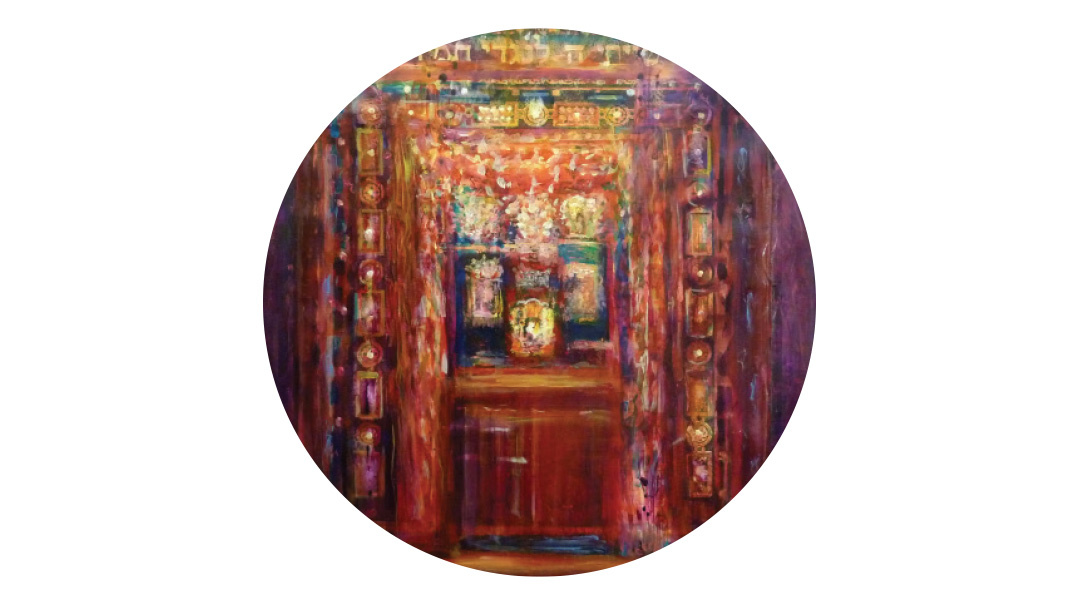Beneath the Facade

Purim grants us the insight to slice through the veil of hester

T
here’s nothing like an approaching Yom Tov to inspire excitement and interrupt the laundry-cooking-bedtime-repeat monotony that takes up much of our time. And depending on our station in life, the amount of cleaning help we have, and how many little people we’re responsible for, adding a few more of these delightful holiday interludes might be our secret wish. However, aside from the Yamim Tovim mandated by the Torah, Chazal, in their wisdom, authorized only two more: Chanukah and Purim.
In the preface to his commentary on the Megillah, Yosef Lekach addresses the dearth of Yamim Tovim sanctioned by Chazal. In playful rhyme, he recounts numerous military victories and miracles we witnessed that would fade into oblivion if not for their codification in Nach. Why weren’t they worthy of a special holiday like Purim? The miracles that abounded when we conquered Eretz Yisrael in Yehoshua’s time were surely outstanding enough to merit yearly celebration! And what of the other wonders Hashem wrought, such as our miraculous victory over Aram during the reign of Achav? Why aren’t they worthy of a Yom Tov?
What is unique about the Purim miracle that sets it apart from other miracles and garners it a coveted day of celebration with its own mitzvos hayom?
A Guide for Galus
In the very first brachah of Shemoneh Esreh, we declare Hashem “haKeil haGadol haGibor v’haNora,” a description of His greatness attributed to Moshe Rabbeinu. Surprisingly, thousands of years ago, this description was in danger of deletion.
The Gemara in Yoma (69b) teaches: “Rabi Yehoshua ben Levi says: Why are they called the Anshei Knesses Hagedolah? Because they restored the crown of old. Moshe said, ‘HaKeil haGadol haGibor v’haNora.’ Yirmiyahu arrived and said, ‘Idol worshippers dance in His sanctuary, where is His [attribute of] nora?’ He ceased saying [the word] nora. Daniel arrived and said, ‘Pagans have enslaved His people, where is His gevurah? He ceased saying gibor. The Anshei Knesses Hagedolah arrived and said, ‘On the contrary, this exhibits His gevurah, that he suppresses His anger and bides His time with idol worshippers. And this exhibits His [attribute of] nora; if not for His nora, how could one nation survive amid 70 [hostile] nations?’”
Yirmiyahu beheld Nevuchadnetzar’s savage henchmen ravage the Makom Hamikdash, shamelessly cavorting over sacred ground. He was no longer capable of uttering “nora.” Daniel observed a nation of prophets and priests enslaved, subjected to the whim of a diabolic king who endeavored to negate the holy. He could no longer give voice to “gibor.”
The Anshei Knesses Hagedolah were profoundly aware of everything their predecessors had seen, and nonetheless identified a kernel hope amid the carnage. What did they see that enabled them to tolerate, and even bless, the apparent demise of Klal Yisrael?
They saw the miracle of Purim.
With the destruction of the first Beis Hamikdash, Klal Yisrael were thrust into a new order. Until the Churban, Hashem’s presence had been so clear, so close, it was an empirical reality. How could they not see Him in the stunning victories He orchestrated through overt miracles, in the devar Hashem that dripped from the mouths of neviim, in the atmosphere of kedushah that saturated the Mikdash and seeped out to infuse the country and its people with holiness. They were a mamleches kohanim v’goy kadosh and it seemed nothing could ever abrogate their status.
And then came the terrible days of Churban, when they were led off to exile, chained and shackled, marched away from a swarming crowd of pagans who defiled the house of Hashem. No more miracles. No more Shechinah.
They were thrust deep into an occluding shroud of galus, and in the dimness that prevailed, they were certain Hashem had abandoned them. When Yirmiyahu and Daniel searched for signs of Hashem’s explicit presence, they were mute with pain. This isn’t the way it’s supposed to be!
Yet although they could no longer see Hashem in the classic, obvious way they had discerned Him in the past, He’d never abandoned them. He’d transitioned them to a new state of being, a state of hester panim. The Anshei Knesses Hagedolah perceived this shift and intuited that although Hashem is no longer apparent in the obvious expressions of miracles and Mikdash, He’s as present as ever, quietly shadowing His beloved nation, yet hardly discernable. Theirs was a crucial awareness, for this would be His method of interface throughout this galus and the next.
Purim, the Yom Tov that honors the hidden hand of Hashem, was the catalyst for their paradigm shift. Here, they watched the wheels of Hashgachah rotating furiously beneath a facade of chaos and disarray. They watched the stunning demise of powerful people, how a fall from grace could be as sudden and startling as a thunderclap, how Hashem doesn’t require His miracles to be evident for them to be effectual, how there is profound power in things that are hidden.
And this message was as crucial as it was enduring, for it would be Klal Yisrael’s illuminating lantern through millennia of galus. Thus Purim, the touchstone for this abiding message, earned a coveted place in our catalogue of Yamim Tovim. It’s the holiday that teaches us how to see Hashem during the interminable years of galus, how to perceive Hashem until He reveals Himself completely with the ultimate Geulah.
The Art of Camouflage
How do we develop the insight to slice through the veil of hester panim?
Rav Shlomo Wolbe observes a remarkable facet of the Purim miracle. Where do we find mention of Mordechai and Esther in the Torah? Mordechai is alluded to in the description of the Ketores offered on Yom Kippur, a spice offering that, when sacrificed, required all the Kohanim to depart from the Heichal (Chullin 139b). This was a korban that demanded absolute privacy.
Esther is alluded to in the Torah with the words “V’anochi haster astir, and I will conceal.” Maseches Megillah (13b) teaches that in the merit of Rochel Imeinu’s tzniyus, Shaul descended from her. And in the merit of Shaul’s tzniyus, Esther descended from him.
Quoting the Maharal (Ohr Chadash), Rav Wolbe points out an outstanding difference between Klal Yisrael’s exile in the period of the Purim story and other exiles. Purim was an instance of double galus; Klal Yisrael were simultaneously enslaved by the Persians under King Achashverosh, and at the same time, they were subject to the evil caprice of Haman, a descendant of Amalek, who represents Galus Edom. Theirs was a “galus b’toch galus,” an exile enclosed within another exile. This form of double galus was an unprecedented experience of hester panim, a double dose of hiddenness whereby Hashem’s presence was obscured by one galus and concurrently by another.
The Purim story teaches us how to cut through the impossible barriers of a double galus and reach Hashem from His place of fathomless hester. In noting where Mordechai and Esther are mentioned in the Torah, Chazal are in fact reflecting on the requisite merits to redeem Klal Yisrael from the dismal abyss of double galus.
Rav Wolbe explains that when Hashem is a state of such profound hester, we’re enjoined to fight fire with fire. The means to access Him in this state is to model the hester He exhibits, and approach Him from a parallel state of being.
“Is Hashem actually hiding His face [during periods of hester panim], chas v’shalom? After all, He perceives us, intervenes on our behalf, and also reveals Himself [when in this state], however, only tznuim discern Him.” (Alei Shur, vol. 2)
A person who has trained herself in the art of tzniyus, in the ability to maintain privacy in the defining aspects of her life, is a person who has developed the tools to perceive Hashem from a place of opacity.
When we practice the art of camouflage, when we don’t advertise all that we are or all that we have, when we focus less on what others know of us, and focus more on what Hashem thinks of us, when we model the facade of an iceberg, concealing more than we reveal, only then are we primed to detect Hashem from His place of Divine concealment as well.
This is the power of Purim, this is the instructive of hester and this is our spiritual legacy until we’re ultimately redeemed from our current galus. May we merit a redemption as they did in their times, bazman hazeh.
Mrs. Elana Moskowitz has been teaching in seminaries for nearly 20 years.
(Originally featured in Family First, Issue 833)
Oops! We could not locate your form.







